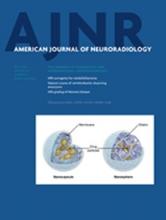Index by author
Kim, S.T.
- BrainYou have accessDifferentiation of Tumor Progression from Pseudoprogression in Patients with Posttreatment Glioblastoma Using Multiparametric Histogram AnalysisJ. Cha, S.T. Kim, H.-J. Kim, B.-j. Kim, Y.K. Kim, J.Y. Lee, P. Jeon, K.H. Kim, D.-s. Kong and D.-H. NamAmerican Journal of Neuroradiology July 2014, 35 (7) 1309-1317; DOI: https://doi.org/10.3174/ajnr.A3876
Kim, Y.K.
- BrainYou have accessDifferentiation of Tumor Progression from Pseudoprogression in Patients with Posttreatment Glioblastoma Using Multiparametric Histogram AnalysisJ. Cha, S.T. Kim, H.-J. Kim, B.-j. Kim, Y.K. Kim, J.Y. Lee, P. Jeon, K.H. Kim, D.-s. Kong and D.-H. NamAmerican Journal of Neuroradiology July 2014, 35 (7) 1309-1317; DOI: https://doi.org/10.3174/ajnr.A3876
Kobayashi, N.
- FELLOWS' JOURNAL CLUBNeurointerventionYou have accessNatural Course of Dissecting Vertebrobasilar Artery Aneurysms without StrokeN. Kobayashi, Y. Murayama, I. Yuki, T. Ishibashi, M. Ebara, H. Arakawa, K. Irie, H. Takao, I. Kajiwara, K. Nishimura, K. Karagiozov and M. UrashimaAmerican Journal of Neuroradiology July 2014, 35 (7) 1371-1375; DOI: https://doi.org/10.3174/ajnr.A3873
More than 100 conservatively managed nonstroke dissecting vertebrobasilar artery aneurysms were followed on average for 3 years. Ninety-seven percent of patients remained clinically unchanged and the 3 patients who deteriorated clinically had aneurysm enlargement. The natural course of these lesions suggests that acute intervention is not always required and close follow-up without antithrombotic therapy is reasonable. Patients with symptoms due to mass effect or aneurysms of >10 mm may require treatment.
Kong, D.-s.
- BrainYou have accessDifferentiation of Tumor Progression from Pseudoprogression in Patients with Posttreatment Glioblastoma Using Multiparametric Histogram AnalysisJ. Cha, S.T. Kim, H.-J. Kim, B.-j. Kim, Y.K. Kim, J.Y. Lee, P. Jeon, K.H. Kim, D.-s. Kong and D.-H. NamAmerican Journal of Neuroradiology July 2014, 35 (7) 1309-1317; DOI: https://doi.org/10.3174/ajnr.A3876
Kuhlman-wood, K.A.
- PediatricsYou have accessThe Diagnostic Value of CT Myelography, MR Myelography, and Both in Neonatal Brachial Plexus PalsyR. Tse, J.N. Nixon, R.S. Iyer, K.A. Kuhlman-Wood and G.E. IshakAmerican Journal of Neuroradiology July 2014, 35 (7) 1425-1432; DOI: https://doi.org/10.3174/ajnr.A3878
Ladner, T.R.
- BrainOpen AccessCerebrovascular Collaterals Correlate with Disease Severity in Adult North American Patients with Moyamoya DiseaseM.K. Strother, M.D. Anderson, R.J. Singer, L. Du, R.D. Moore, Y. Shyr, T.R. Ladner, D. Arteaga, M.A. Day, P.F. Clemmons and M.J. DonahueAmerican Journal of Neuroradiology July 2014, 35 (7) 1318-1324; DOI: https://doi.org/10.3174/ajnr.A3883
Landtblom, A.-M.
- BrainOpen AccessEffects of Gadolinium Contrast Agent Administration on Automatic Brain Tissue Classification of Patients with Multiple SclerosisJ.B.M. Warntjes, A. Tisell, A.-M. Landtblom and P. LundbergAmerican Journal of Neuroradiology July 2014, 35 (7) 1330-1336; DOI: https://doi.org/10.3174/ajnr.A3890
Lawton, M.T.
- FELLOWS' JOURNAL CLUBNeurointerventionOpen AccessInfluence of Patient Age on Angioarchitecture of Brain Arteriovenous MalformationsS.W. Hetts, D.L. Cooke, J. Nelson, N. Gupta, H. Fullerton, M.R. Amans, J.A. Narvid, P. Moftakhar, H. McSwain, C.F. Dowd, R.T. Higashida, V.V. Halbach, M.T. Lawton and H. KimAmerican Journal of Neuroradiology July 2014, 35 (7) 1376-1380; DOI: https://doi.org/10.3174/ajnr.A3886
Over 800 AVMs were retrospectively reviewed to determine if clinical and angioarchitectural features varied between children and adults. The authors found that hemorrhages and exclusively deep venous drainage were more common in children but high-risk features such as venous ectasia and feeding artery aneurysm were more common in adults. Thus, these latter high-risk features may take time to develop.
Lee, J.Y.
- BrainYou have accessDifferentiation of Tumor Progression from Pseudoprogression in Patients with Posttreatment Glioblastoma Using Multiparametric Histogram AnalysisJ. Cha, S.T. Kim, H.-J. Kim, B.-j. Kim, Y.K. Kim, J.Y. Lee, P. Jeon, K.H. Kim, D.-s. Kong and D.-H. NamAmerican Journal of Neuroradiology July 2014, 35 (7) 1309-1317; DOI: https://doi.org/10.3174/ajnr.A3876
Lee, V.H.
- EDITOR'S CHOICEBrainYou have accessPerfusion-Based Selection for Endovascular Reperfusion Therapy in Anterior Circulation Acute Ischemic StrokeS. Prabhakaran, M. Soltanolkotabi, A.R. Honarmand, R.A. Bernstein, V.H. Lee, J.J. Conners, F. Dehkordi-Vakil, A. Shaibani, M.C. Hurley and S.A. AnsariAmerican Journal of Neuroradiology July 2014, 35 (7) 1303-1308; DOI: https://doi.org/10.3174/ajnr.A3889
The authors attempted to determine if reperfusion therapy for anterior circulation acute stroke based on MR perfusion resulted in better outcomes at 3 months than that based on noncontrast CT. Perfusion imaging-selected patients had a better outcome than those selected with only noncontrast CT but MR perfusion- and CT perfusion-selected patients had similar outcomes. In this multicenter study, patients with acute stroke who underwent perfusion imaging were more than 2-fold more likely to have good outcomes following endovascular reperfusion therapy








